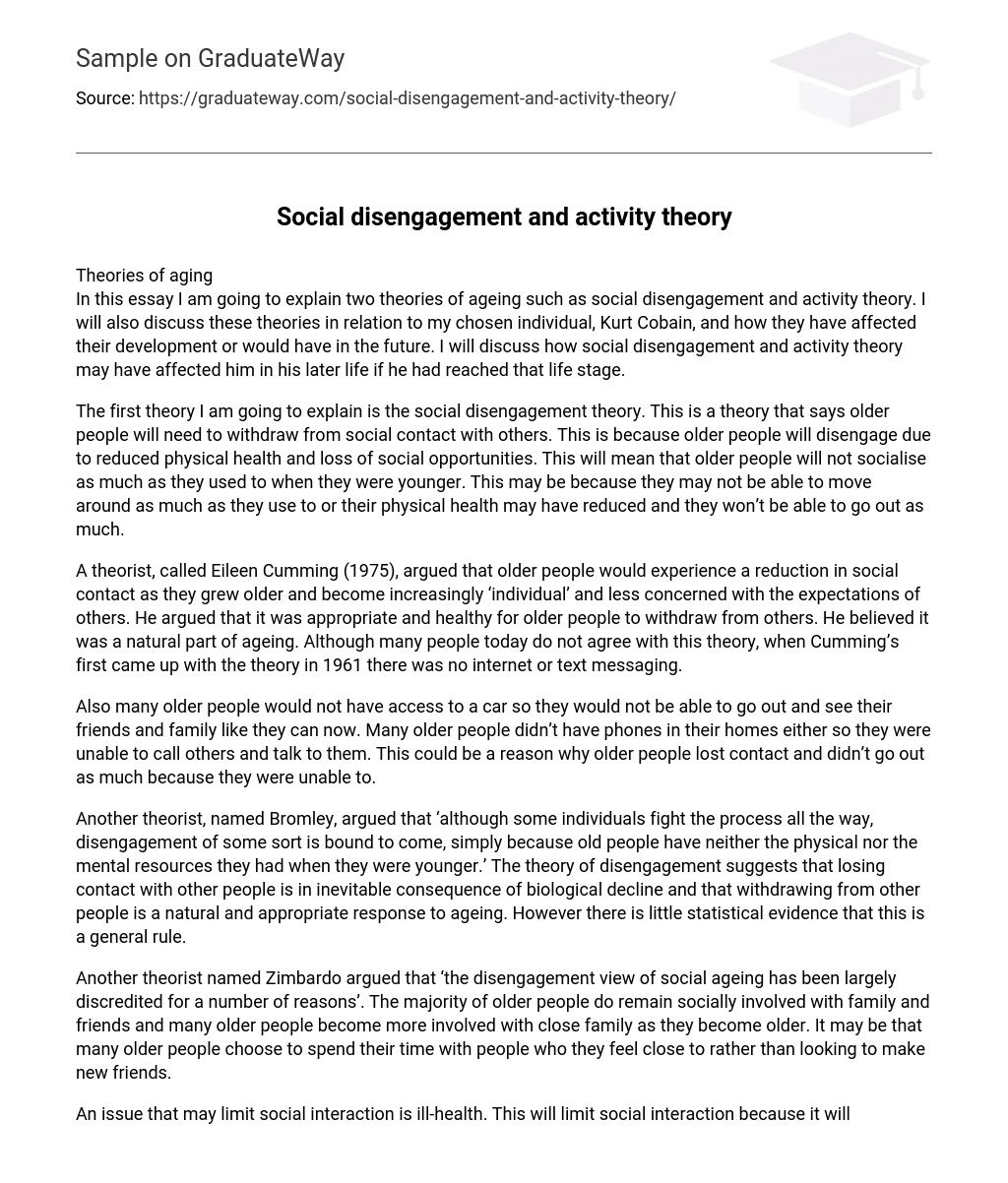Theories of Aging
In this essay, I am going to explain two theories of aging: social disengagement and activity theory. I will also discuss these theories in relation to my chosen individual, Kurt Cobain, and how they have affected his development or would have in the future. I will discuss how social disengagement and activity theory may have affected him in his later life if he had reached that life stage.
The first theory I am going to explain is the social disengagement theory. This theory states that older people will need to withdraw from social contact with others because of reduced physical health and loss of social opportunities. This means that older people will not socialize as much as they used to when they were younger. This may be because they are not able to move around as much as they used to or their physical health may have declined, preventing them from going out as much.
A theorist called Eileen Cumming (1975) argued that older people would experience a reduction in social contact as they grew older and become increasingly individual” and less concerned with the expectations of others. She argued that it was appropriate and healthy for older people to withdraw from others. She believed it was a natural part of aging. Although many people today do not agree with this theory, when Cumming first came up with the theory in 1961, there was no internet or text messaging.
Also, many older people would not have access to a car, so they would not be able to go out and see their friends and family like they can now. Additionally, many older people did not have phones in their homes, so they were unable to call others and talk to them. This could be a reason why older people lost contact and didn’t go out as much because they were unable to.
Another theorist, named Bromley, argued that although some individuals fight the process all the way, disengagement of some sort is bound to come, simply because old people have neither the physical nor the mental resources they had when they were younger.” The theory of disengagement suggests that losing contact with other people is an inevitable consequence of biological decline and that withdrawing from other people is a natural and appropriate response to aging. However, there is little statistical evidence that this is a general rule.
Another theorist named Zimbardo argued that the disengagement view of social aging has been largely discredited for a number of reasons.” The majority of older people do remain socially involved with family and friends, and many older people become more involved with close family as they age. It may be that many older people choose to spend their time with people whom they feel close to rather than looking to make new friends.
An issue that may limit social interaction is ill-health. This will limit social interaction because it may result in poor mobility, hearing problems, or vision issues. These factors can make it difficult to travel and see others. Another issue that can limit social interaction is geographical mobility. For example, if someone moves away, they will be further from friends and family. This can be especially challenging for older people who may not have access to a car. Retirement is another issue that can limit social interaction. As people stop working, they may not see their colleagues as frequently as they did before.
Social disengagement theory may have affected Kurt Cobain in a number of ways. He suffered from chronic bronchitis and a heart condition, which could have been made worse later in life. This could have led to him not being able to go out and socialize with his friends and family. When Kurt was in early adulthood, he hardly saw his friends as he suffered from depression. As Kurt did not want any help, this may have increased throughout his life.
This may have led to him not socializing and seeing friends and family. As he reached later adulthood, he may have suffered from more problems, such as not being able to move around as easily. This could mean that he wasn’t able to go out a lot, which would mean that he wouldn’t be socializing as much. We can only guess what may have happened, though, as he died at a young age and did not reach later adulthood.
Another theory of aging is the activity theory. The activity theory is different from the social disengagement theory because it suggests that older people should still be involved in activities. In 1961, Bromley argued that older people need to disengage but also need to remain active” to prevent disengagement from going too far. He said, “It is not sufficient merely to provide facilities for elderly people.”
They need to be educated to make use of them and encouraged to abandon apathetic attitudes and fixed habits. Bromley argued that it is important to remain mentally active, maintain an interest in life, and enjoy the company of others. Too much disengagement would lead to stagnation” and a loss of mental and physical skills.





